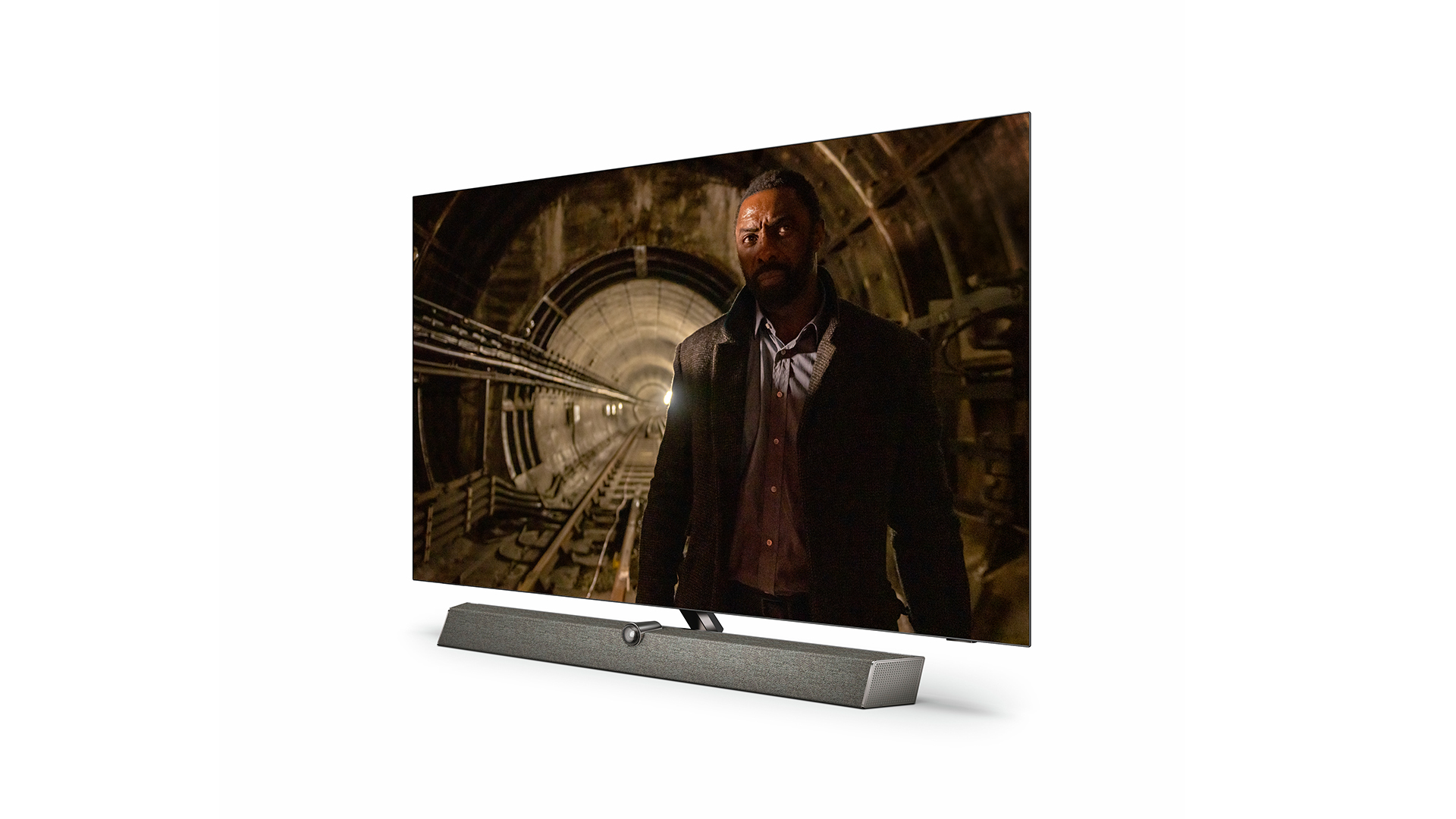What Hi-Fi? Verdict
From its Ambilight-enhanced design to its ground-breaking pictures and class-leading sound, the OLED937 is arguably the most all-round spectacular TV we’ve tested
Pros
- +
Stunning design
- +
Remarkably bright, colourful, sharp
- +
Spectacularly powerful audio
Cons
- -
Dolby Vision can look noisy
- -
Somewhat complicated to use
- -
Android TV won’t suit everyone
Why you can trust What Hi-Fi?
The 65OLED937 is arguably the purest example yet of Philips’ current TV philosophy. For starters, as its name suggests, it’s an OLED TV – the screen technology that’s been at the forefront of the Philips brand’s renaissance in recent years. It also provides a glorious showcase for Philips’ unique Ambilight design technology, and its pictures are driven by the latest version of a typically ultra-powerful trademark picture processing engine.
Also, it doesn’t just feature another sound system designed by Brit hi-fi powerhouse Bowers & Wilkins; it features a full multi-channel speaker system so large and powerful that it has to be housed in an external enclosure that also doubles as the TV’s desktop stand. Designed by Brit hi-fi powerhouse Bowers & Wilkins.
Price
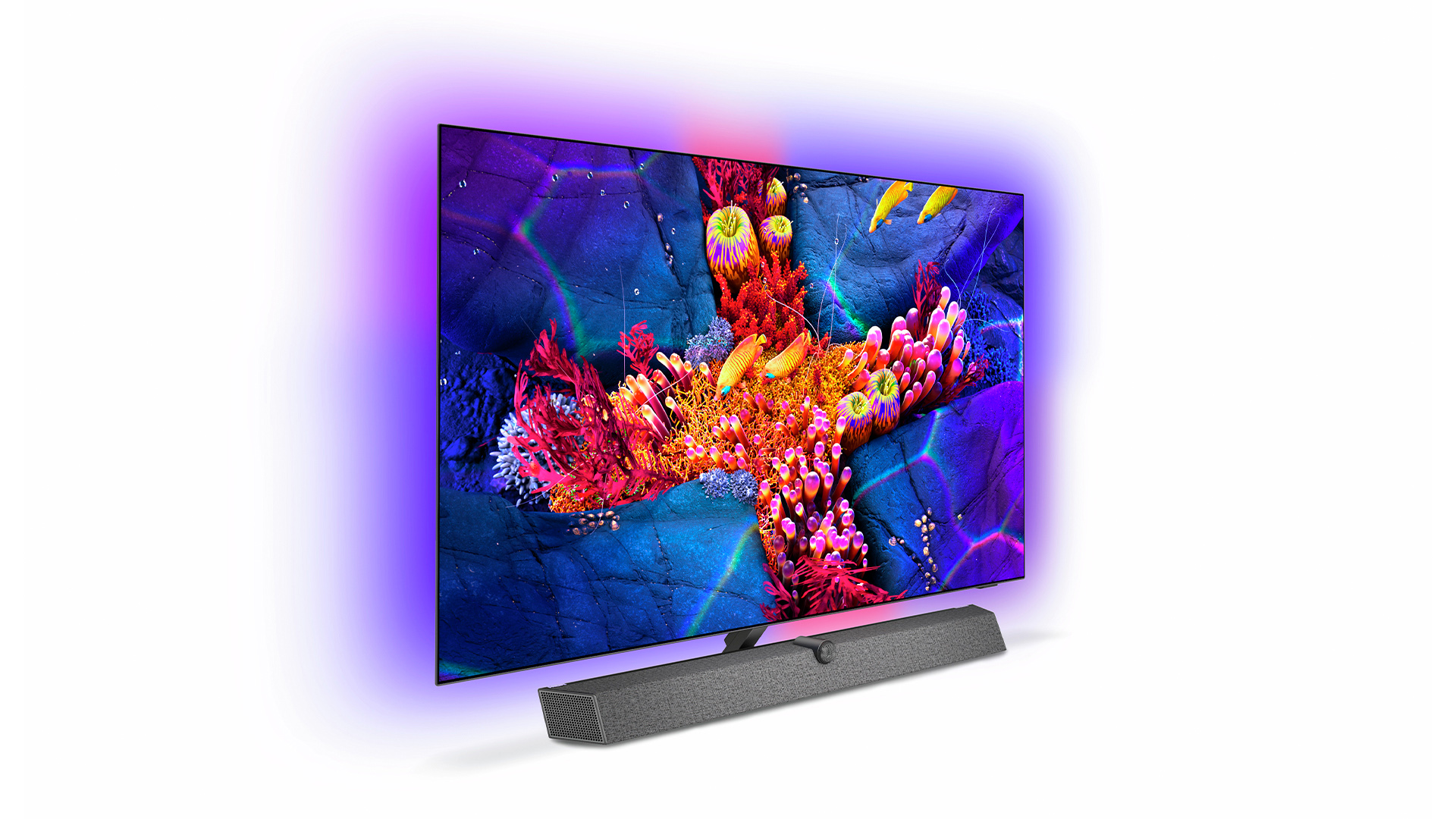
Getting a 65-inch TV packing as many features and as much cutting-edge performance as the 65OLED937 for £2899 (around $3575 / AU$5075) looks at first glance like merely a solid rather than spectacular deal. Its most obvious rivals these days, after all, are the LG OLED65G2 and Panasonic TX-65LZ2000 (the latter of which also features an advanced built-in multi-channel audio system), which cost just £2299 / $2000 / AU$3498 and £2499 (around $3080 / AU$4375) respectively.
The 65OLED937 does have a couple of tricks up its sleeve, though, that will – for some buyers at least – make the extra outlay worthwhile. They are a new and improved version of Philips’ gorgeous and immersive Ambilight technology, which bathes the screen in surrounding light that can match the pictures you’re watching, and an external yet still built-in (we’ll explain this later) sound system that may just be the best integrated audio system in town.
The 65-inch OLED937 is joined by a 77-inch version that costs £3999 (around $4950 / AU$6975). Note that the Philips brand in Europe is owned by TP Vision, and its products are not to be confused with anything that might come out under the Philips banner in the US. Also, as far as we can tell, Philips hasn’t updated its premium product range in Australia for a couple of years, so the OLED937 isn’t available there.
Design
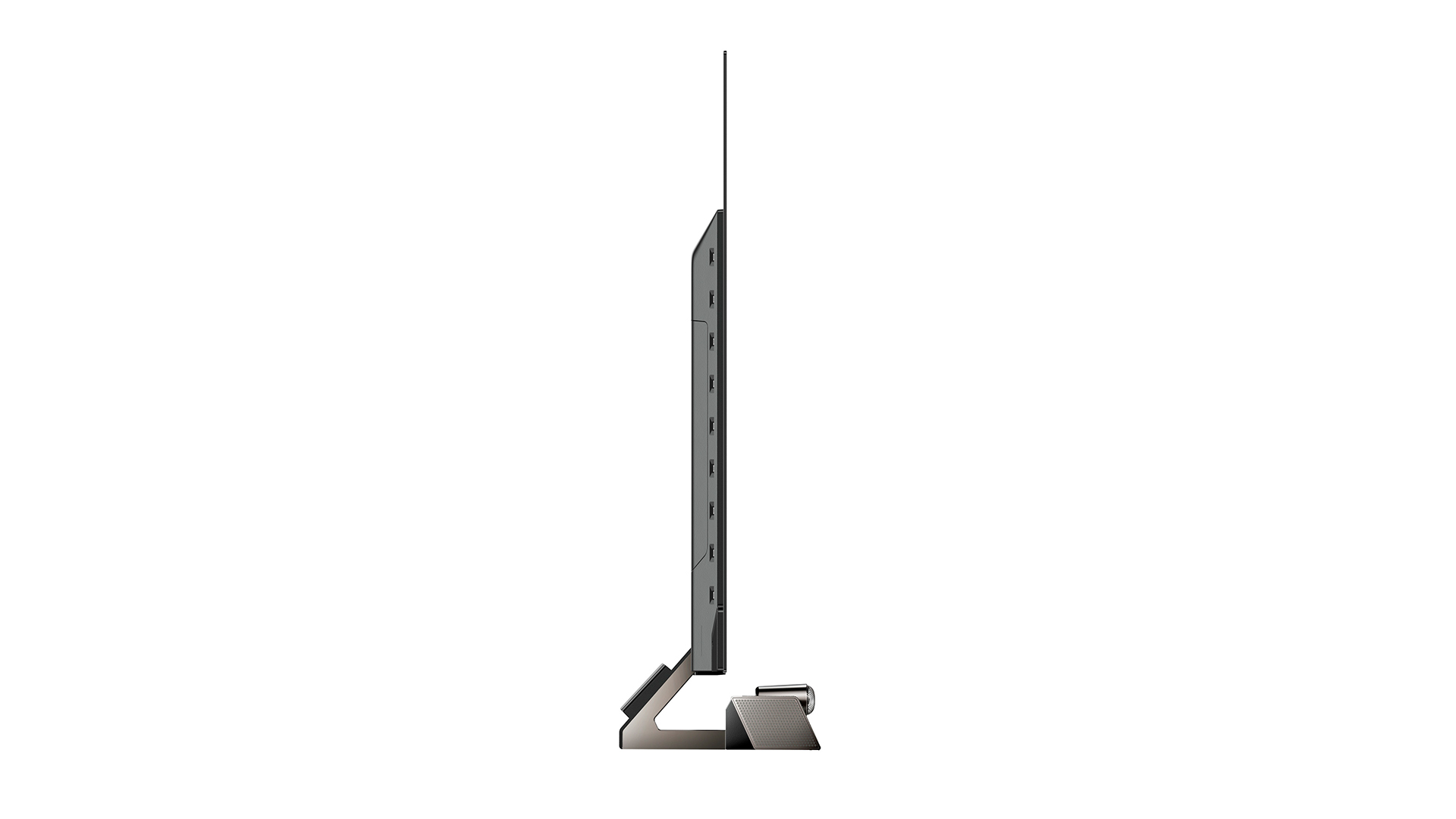
Thanks to its combination of a beautiful metallic finish, super-thin panel design, external speaker enclosure (complete with Bowers & Wilkins’ distinctive ‘tweeter on top’) and a new and improved, four-sided version of Philips’ Ambilight technology, the 65OLED937 is arguably the most dramatic-looking ‘mainstream’ TV around today.
The way Ambilight casts its unique splay of coloured light beyond the screen is particularly eye-catching. Especially if the array of LEDs mounted behind all four of the TV’s edges is set to track the position and hue of the colour in the pictures you’re watching. Philips has further refined the accuracy of this Ambilight option for the 65OLED937, too, making it even more simultaneously spectacular and immersive.
The external speaker enclosure (don’t call it a soundbar or Bowers & Wilkins will hunt you down) merits more discussion, too. For starters, the way it’s integrated into the design so that it becomes the front part of the 65OLED937’s desktop stand is genius. Its silvery felt finish looks lovely and enjoys a real premium feel, while its angular shape looks stylish while also helping the speaker array tucked inside deliver its multi-channel sound more effectively. The tweeter on top is as cute as the proverbial button while also, of course, enabling greater treble and vocal clarity.
The 65OLED937’s brilliant blend of form and function is rounded out by the provision in the box of a bracket that lets the speaker enclosure sit just below the screen against your wall if you decide to wall-mount the TV.
Shipped with the 65OLED937 is a very attractive, premium-build remote control that’s beautiful to handle. The only catch is that it’s very button-intensive, and the layout of those buttons doesn’t always feel particularly logical.
Features
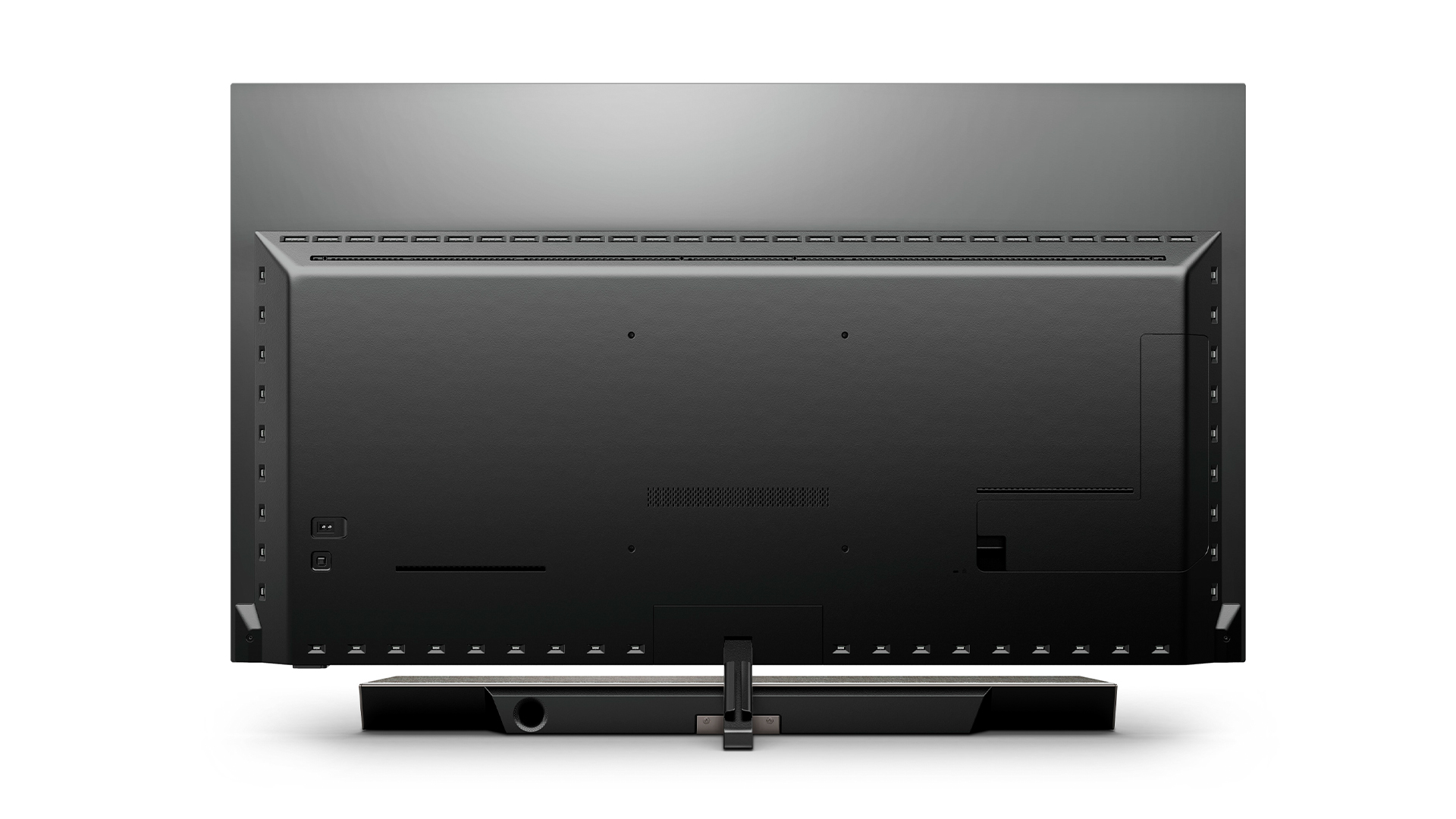
We should start this section with a quick recap of key 65OLED937 features we’ve already covered. Namely its Ambilight design feature, its unique Bowers & Wilkins speaker system, and its picture’s combination of self-emissive OLED technology and the latest Philips processing engine. Some of these deserve a bit more detail, though.
The external speaker system delivers a maximum of 95W across a 5.1.2-channel configuration, with the .2 part alerting us to a pair of up-firing drivers, each driven by 12.5W of amplification, to back up the TV’s Dolby Atmos playback capability. The other channels include 2 x 10W power for the fronts, a subwoofer driven by a 20W amp, the tweeter on top (5W), and two ‘surround’ channels (12.5W).
Unlike most brands, who like to be coy about the specifics of the panel they’re using in their OLED TVs, Philips happily confirms that the 65OLED937 features one of LG Display’s latest EX panels, which deliver significantly more full-screen and peak brightness than older designs. And since every pixel in an OLED TV can deliver its own light, this new brightness should have no negative impact on the screen’s black levels, hopefully enabling the 65OLED937’s contrast performance to be even more dazzling than that of previous Philips OLED TVs.
The picture processor sported by the 65OLED937 is the top-tier version of Philips’ latest P5 Gen 6 picture engine. By top tier, we mean that it uses two chips to deliver its immense amounts of power, rather than the single chip found in cheaper Philips models such as its OLED807s. As well as the extra real-time power, the twin-chip approach allows Philips to add one or two significant extra features to the 65OLED937 that you don’t get with the brand’s OLED807. Most notably, there’s an Advanced HDR system that optimises detail, brightness and colour based on analysis of every single frame of an HDR10 source. There’s also greater use of AI machine learning techniques across multiple picture performance areas on the higher-end TV, as well as a return of the new Ambient Detection features also found on the OLED807. These analyse your room conditions much more thoroughly than regular ‘ambient light compensation’ systems to try and continually optimise picture quality.
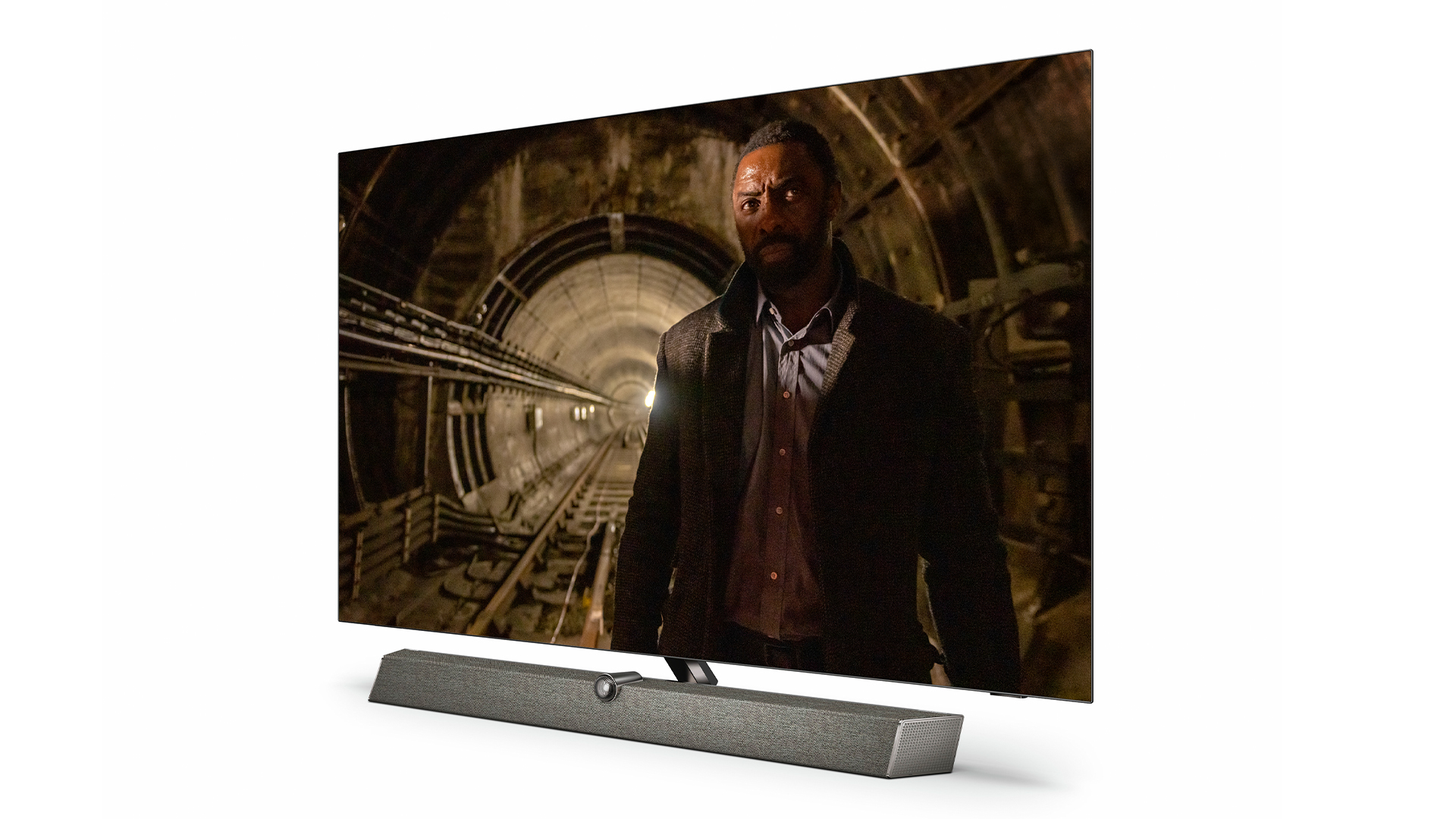
Screen size 65 inches (also available in 77 inches)
Type OLED
Resolution 4K
HDR formats HLG, HDR10, HDR10+, Dolby Vision
Operating system Android TV
HDMI inputs x4
HDMI 2.1 2 x 48Gbps
Gaming features 4K/120Hz, VRR, ALLM
ARC/eARC eARC
Optical output? Yes
Dimensions (hwd) 83 x 144 x 27cm
The core of the latest P5 processor remains, as ever, its many carefully ordered steps for improving the five key aspects of picture quality: colour, motion, sharpness, contrast and source identification.
The 65OLED937’s HDR support is excellent. As well as the now de rigueur HDR10 and HLG, it caters for both of the ‘premium’ HDR10+ and Dolby Vision formats, with their extra scene-by-scene picture data. This means, simply, that the TV will always take in the best version of any content you feed it. If only all TV brands would take such an apolitical, consumer-friendly stance on the HDR experience.
Connections on the 65OLED937 include four HDMIs, two of which can handle the full HDMI 2.1 feature count of 4K/120Hz, VRR, ALLM and eARC audio pass-through. While this is reasonably good news for gamers, some rivals support all the HDMI 2.1 features described above on all four HDMI ports, not just two. Also, confusingly, you need to delve into the TV’s menus to ensure that the two full-bore HDMI 2.1 ports have been set to their Optimal Game settings before the gaming features ‘unlock’.
The biggest issues for gamers, though, are that input lag is a little higher, at 21.2ms, than we see with most premium TVs these days (though 21.2ms still represents less than a frame), and that while the TV will accept 4K/120Hz feeds, these will actually only appear with half the vertical resolution they ought to. This does result in a softer, less detailed look to 4K/120 images than you get with TVs that can properly support such feeds. Though, as we’ll see, this doesn’t mean the 65OLED937 isn’t capable of looking very good indeed with gaming sources.
The 65OLED937’s smart features are provided by Android TV. It’s a shame, perhaps, that a TV as forward-thinking as this hasn’t migrated to the better-presented, more user-friendly Google TV platform. To be fair, though, while Android TV isn’t the most appealing smart TV interface, the 65OLED937 continues Philips’ winning streak of handling Android TV more stably and slickly than many rival TVs do. It also provides Freeview Play to get around Android TV’s lack of one or two of the catch-up apps for the main UK terrestrial broadcasters.
Picture
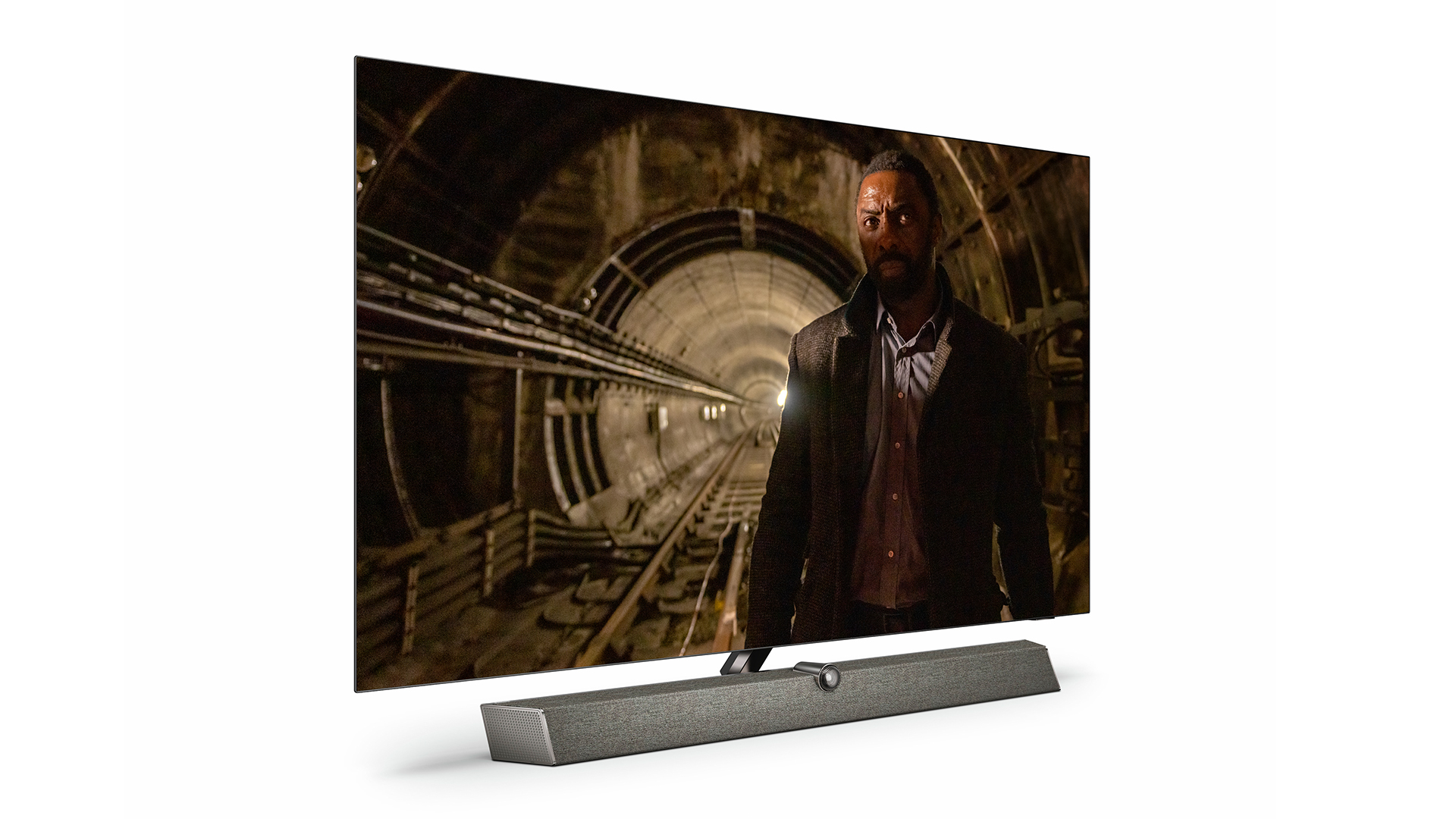
The 65OLED937’s pictures manage to keep the spectacular feel going. As we might have expected given Philips’ penchant for going ‘all out’ with its TV pictures, this OLED model grabs the new brightness potential made possible by its EX OLED panel with both hands, pumping out the brightest, most vibrantly saturated high dynamic range pictures we’ve seen from any OLED TV on the market today bar Samsung’s S95B QD-OLED.
Even LG’s gorgeous G2 series, which also uses the new EX panel and a heatsink element, doesn’t seem to push quite as far in brightness terms as the 65OLED937 – at least when it comes to classic bright HDR highlights such as glints of sunlight reflecting off metal or glass.
These small patches of extreme brightness appear with unfettered intensity alongside just the sort of immaculately deep, natural and neutral black levels we’re familiar with seeing now from the best OLED TVs, leading to a truly stunning contrast performance. OLED’s self-emissive pixels, after all, mean that there’s no need for any sort of compromise to either the brightest or darkest pixels, even if they happen to sit right alongside each other. You haven’t seen an HDR starfield until you’ve seen it on a 65OLED937.
The intensely deep black levels are consistent, too, with the extra brightness of which the screen is capable, happily not ushering in a return to the sort of inconsistencies or noise that once used to afflict some OLED TVs.
The P5 processor also wastes no time in making use of the EX panel’s higher brightness when it comes to colour. Philips can usually be depended upon to deliver some of the TV world’s most potent, vibrant colour scapes, at least when using out-of-the-box picture presets, and this is true of the 65OLED937 – but turned up to 11.
The set’s new Crystal Clear preset (essentially the new name for the brand’s previous Vivid mode) can occasionally push the colour potency too far, becoming a touch cartoonish, but we still predict that most users will prefer the punchy Crystal Clear or Standard presets to the more accurate but also more muted-looking Movie or Filmmaker Mode presets.
That said, it’s seriously welcome to find the 65OLED937 providing the latter two picture options (along with support for the third-party IMAX Enhanced ‘format’) for viewers who really do like a more restrained, ‘authentic’ look to their TV pictures. Philips no longer takes the ‘my way or the highway’ approach to picture quality it could perhaps have been accused of a few generations ago.
The 65OLED937 manages to look exceptionally sharp and detailed with both native 4K and upscaled HD footage. This feels as much a result of the TV’s exceptional contrast and light control than any simple sharpness processing, too, so there’s nothing forced or overly gritty about it. This is one area in particular, in fact, alongside a slightly more dynamic feel to HDR10 content, where the 65OLED937 seems to improve on the picture quality of Philips’ step-down OLED807 OLED range.
With the 65OLED937’s motion processing in play, meanwhile, its outstanding sharpness remains completely intact when the 65OLED937 has to cope with lots of movement – even during 24p movies. As ever with Philips TVs, some of the motion processing options can overcook things, causing either too much over-smooth ‘soap opera effect’, or too many distracting processing side effects. Here again, though, Philips has become much more pragmatic than it used to be, now offering Pure Cinema and Movie motion processing options that are gentle and intelligent enough to take the ugly edge off 24p judder without causing any significant unwanted side effects
While consistently and joyfully spectacular, the 65OLED937’s picture quality isn’t entirely flaw free. Perhaps the strangest issue is that Dolby Vision playback just doesn’t quite look right at times. Colours sometimes look too aggressive, which can contribute to noise in some areas of the picture that you don’t get with other sets. Dark Dolby Vision scenes can lose a little subtle shadow detailing too, despite the format’s extra scene-by-scene image data usually helping TVs deliver HDR’s expanded light range better. Strange.
These issues might even persuade you to turn Dolby Vision off on your sources where possible – especially as the 65OLED937’s Advanced HDR processing does such a fantastic job with regular HDR10 feeds.
Philips’ new Ambient AI feature is a bit of a letdown too, chiefly because it tends to leave HDR pictures too dull for comfort if you’re watching the 65OLED937 in a very dark room. You can turn the feature off, thankfully, but it feels in its current form like a missed opportunity.
It feels, too, as if some of the provided picture tweaks can work against each other. For instance, running the Advanced HDR Tone Mapping feature in conjunction with the Maximum HDR Perfect setting can cause dark scenes to start to look a bit unstable.
This brings us to the final ‘cost’ of the 65OLED937’s spectacular approach to picture quality: the need to learn your way around and potentially repeatedly spend quite a bit of time tinkering with the TV’s sprawling picture settings if you want to consistently get the best out of it. The 65OLED937 is actually more forgiving out of the box than the OLED807s, though. Also, given how good its ‘best’ tends to be, for most AV enthusiasts any time and effort spent on raising the 65OLED937 to its spectacular best will feel well and truly worth it.
Sound
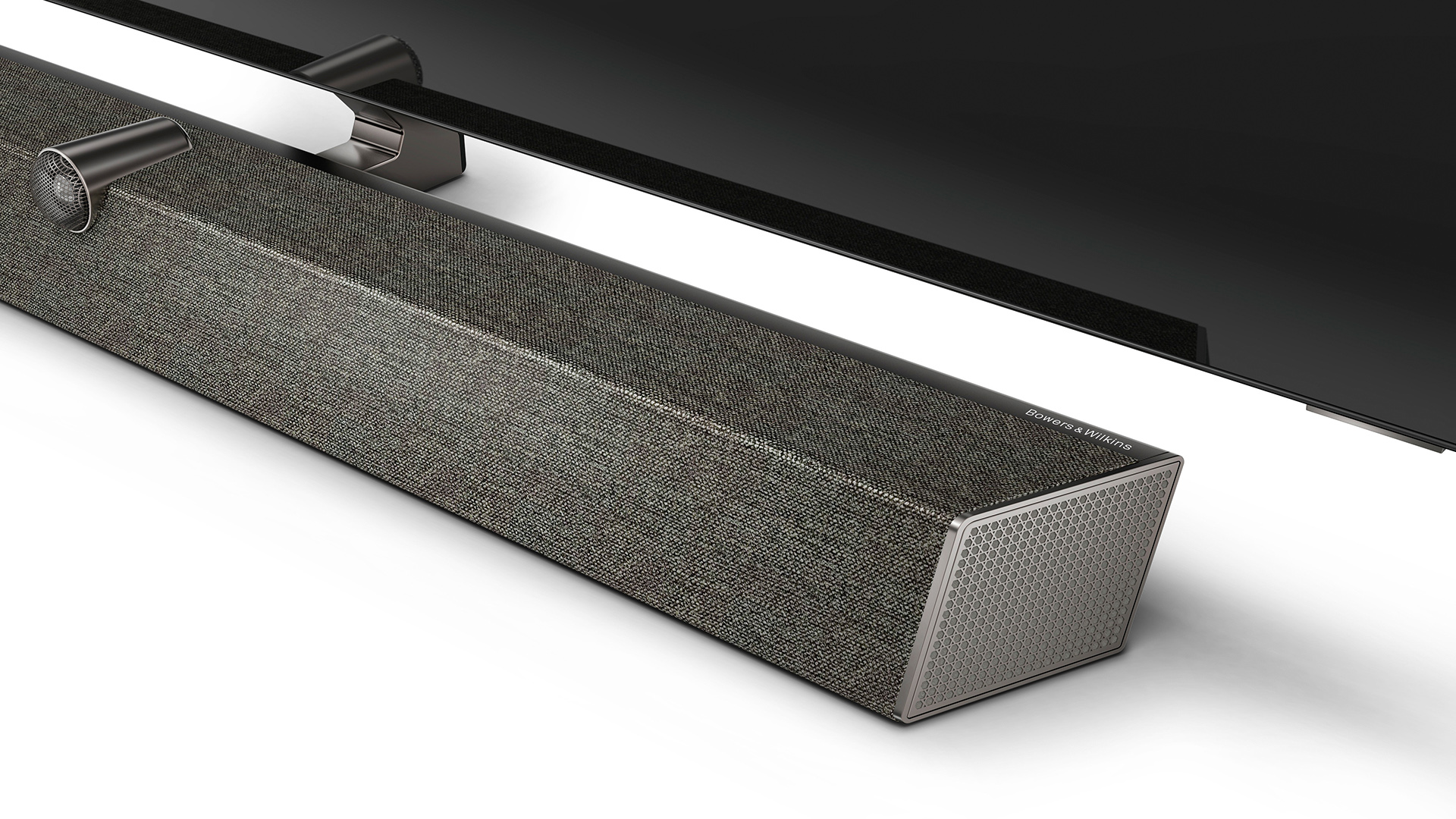
Fans though we typically are of Bowers & Wilkins products, be they hi-fi speakers or Philips TV audio systems, we didn’t fully warm to the sound of the OLED937’s predecessor. Despite it also sporting an external multi-channel speaker enclosure, something about its sound left us feeling a little cold. Especially when you’re talking about a TV that commands quite a price premium over OLED TVs that don’t feature such high-falutin’ integrated audio.
Happily, the 65OLED937 sees – or rather, hears – B&W delivering significant improvements that lift the new set’s sound into truly five-star territory.
The size of the soundstage the 65OLED937 can produce, for starters, is both bigger and, more importantly, more accurately defined than that of its predecessor. This is especially noticeable when it comes to height/vertical effects in a Dolby Atmos mix, but the whole soundstage has a more effective, accurate, three-dimensional and immersive presence.
The 65OLED937 handles bass better than its predecessor too. Low-frequency sounds reach deeper, sound smoother, and enjoy more frequency variation and responsiveness, while also avoiding significant phutting and buzzing issues with even the most demanding of movie basslines. How B&W has managed to get so much bass from the 65OLED937’s external speaker enclosure without using an external subwoofer is beyond us. Especially as the bass is delivered without feeling dislocated from or impinging on the audio system’s impressively open and dynamic mid-range.
Voices are clean, clear and well-contextualised at all times, avoiding the ‘hummy’ feeling with deep male voices or the shrillness with high-pitched female voices that so many TV sound systems suffer with.
There is still room for further improvement. The sound can still sometimes feel a little detached from the pictures on the screen, despite the obvious improvements in (especially vertical) staging, particularly when it comes to dialogue. Overall, though, the 65OLED937 is comfortably one of the best-sounding TVs we’ve tested, and its improvements mean that it justifies its price hike over its cheaper siblings more successfully than its predecessor.
Verdict
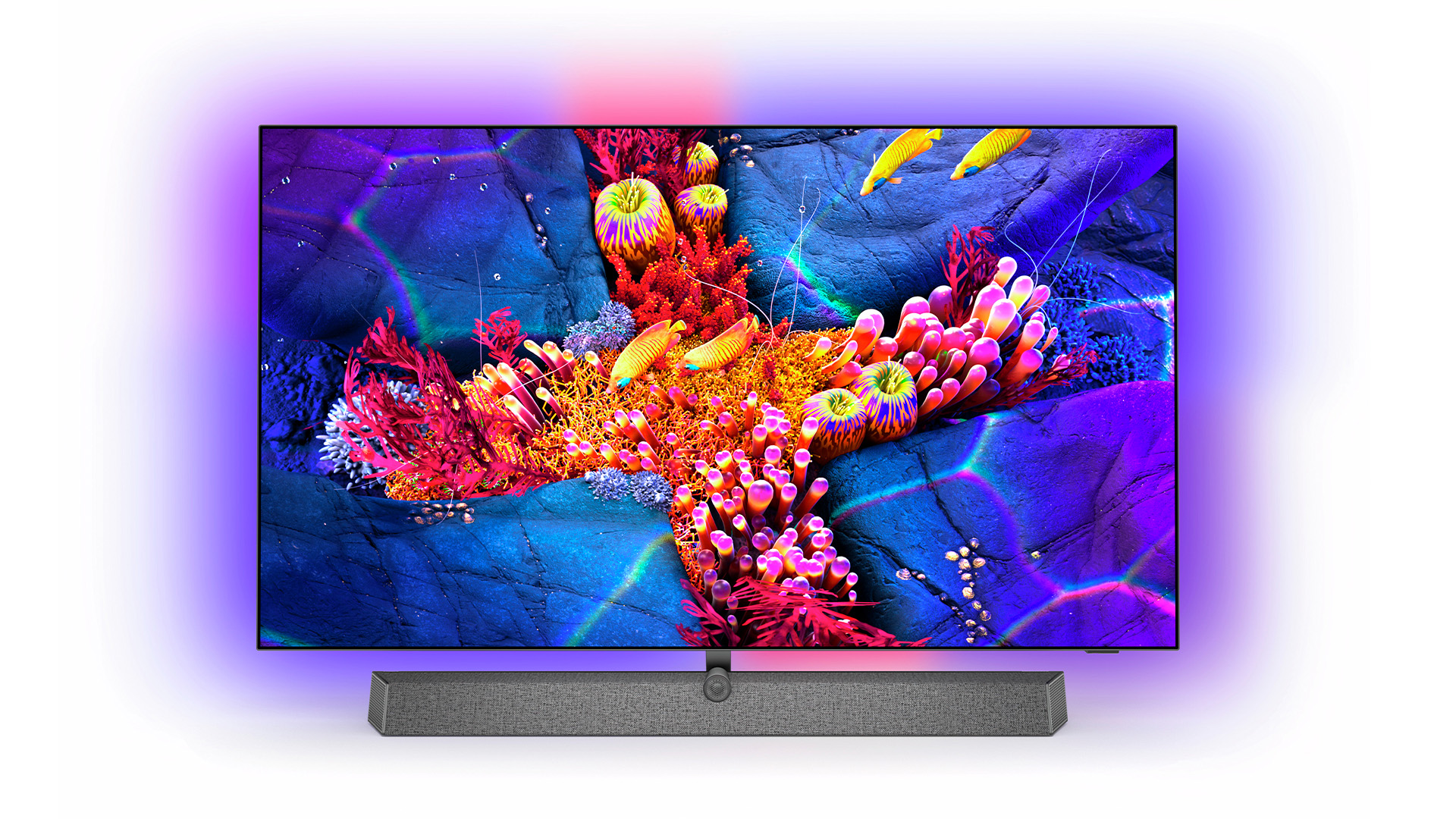
From its gleaming, slinky and Ambilight-enhanced design to its ground-breakingly bright, colourful pictures and class-leadingly powerful sound, the 65OLED937 is arguably the most all-round spectacular TV we’ve tested.
SCORES
- Picture 5
- Sound 5
- Features 5
MORE:
Read our review of the Samsung QE65S95B
Also consider the Sony XR-65A95K
Read our LG OLED65G2 review
John Archer has written about TVs, projectors and other AV gear for, terrifyingly, nearly 30 years. Having started out with a brief but fun stint at Amiga Action magazine and then another brief, rather less fun stint working for Hansard in the Houses Of Parliament, he finally got into writing about AV kit properly at What Video and Home Cinema Choice magazines, eventually becoming Deputy Editor at the latter, before going freelance. As a freelancer John has covered AV technology for just about every tech magazine and website going, including Forbes, T3, TechRadar and Trusted Reviews. When not testing AV gear, John can usually be found gaming far more than is healthy for a middle-aged man, or at the gym trying and failing to make up for the amount of time he spends staring at screens.
-
JEMOEDER Good review, as was the review for the 907. Could you maybe do a direct comparison between the 2 models? That would be awesome, I'm definitely getting one or the other this year. Kind regards, Ross.Reply
